Innovations in Sustainable Water Infrastructure
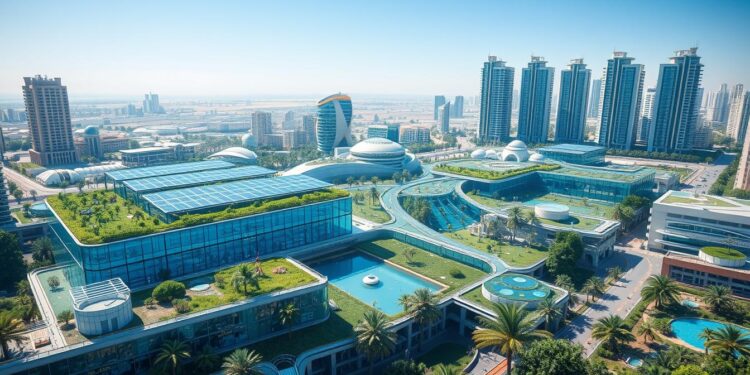
Global water management is changing fast thanks to new tech and environmental issues. Recent research looked at 3,771 startups and scaleups in water management. These innovations are changing how we use water in communities.
Digital water management is a big deal now. It uses AI, IoT sensors, and advanced meters. These smart systems are making old ways of managing water better by using real-time data and smart monitoring.
The Water Management Innovation Map shows eight key trends for 2025. It points out the need for sustainable water solutions. New tech like geographical information systems, digital twins, and augmented reality help find problems and use resources better.
Table of Contents
- 1 The Evolution of Modern Water Infrastructure
- 2 Digital Transformation in Water Management
- 3 Smart Water Systems and IoT Integration
- 4 Advanced Filtration Technologies
- 5 Nanotechnology Applications in Water Treatment
- 6 Innovations in Sustainable Water Infrastructure
- 7 Wastewater Processing and Recovery Systems
- 8 Decentralized Water Infrastructure Solutions
- 9 Climate-Resilient Water Systems
- 10 Green Infrastructure Integration
- 11 Water Conservation Technologies
- 12 Emerging Desalination Technologies
- 13 Sustainable Urban Water Management
- 14 Infrastructure Monitoring and Maintenance
Key Takeaways
- 3,771 global startups driving water infrastructure innovation
- Digital technologies transforming water management strategies
- AI and IoT sensors creating smarter water infrastructure
- Increasing focus on sustainable and adaptive water solutions
- Technological advancements improving resource efficiency
The Evolution of Modern Water Infrastructure

Water infrastructure has changed a lot over time. It started with ancient aqueducts and now we have complex systems. This shows how we’ve learned to manage water better and use it wisely.
Historical Development of Water Systems
Early people knew water was key to survival. They built water systems that showed great engineering skills. These systems grew from simple channels to big networks that moved water far.
Current Challenges in Infrastructure Management
Today, water systems face big problems that need new solutions. There are major issues:
- Over 2 million Americans lack access to safe drinking water
- Nearly 6 billion gallons of treated water are lost daily through leaking pipes
- The American Society of Civil Engineers graded U.S. drinking water infrastructure with a C-
The Need for Sustainable Solutions
Now, we need water systems that can handle climate changes. We need new tech and smart plans to make water systems that last.
“Water is the driving force of all nature.” – Leonardo da Vinci
Here are some ways to make water systems better:
- Use smart monitoring systems
- Try new water treatment tech
- Start community programs
- Design infrastructure that can withstand changes
By using new tech and smart plans, we can make water systems strong. This way, we can keep water flowing for our kids and grandkids.
Digital Transformation in Water Management
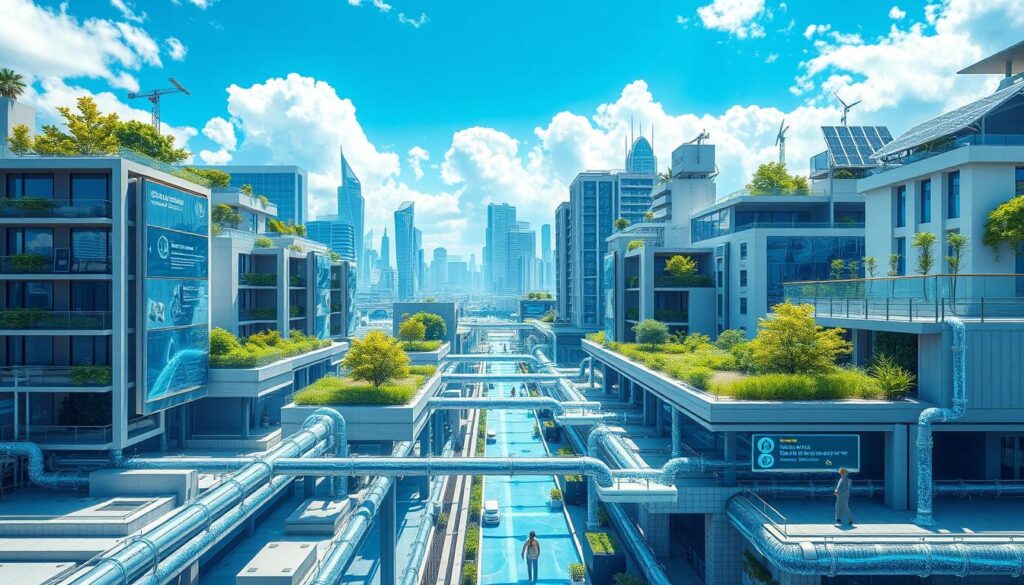
The world of water management is changing fast thanks to digital transformation. Smart water systems are key in solving global water problems. Tools like artificial intelligence, IoT sensors, and advanced meters are changing how we watch and manage water.
“Digital technologies are not just improving water management—they’re reimagining our entire approach to water conservation”
Some big changes in digital water management include:
- Real-time water quality monitoring
- Remote asset management
- Predictive maintenance systems
- Advanced data analytics
Water-saving tech is making a big difference. Companies using digital tools see big wins, like:
| Digital Technology | Performance Improvement |
|---|---|
| IoT Sensors | 20-30% Water Loss Reduction |
| AI Predictive Analytics | 15% Operational Cost Reduction |
| Smart Metering | 25% Faster Response Times |
Using systems like GIS, digital twins, and AR is changing how we see and manage water. These tools help find problems early, making water management more proactive.
By making decisions based on data, water companies can work better, waste less, and help keep water resources safe. The future of water systems is all about these digital changes.
Smart Water Systems and IoT Integration
The digital revolution is changing water infrastructure with smart water management systems. IoT technologies are making it possible to monitor, analyze, and control water with great precision and efficiency.
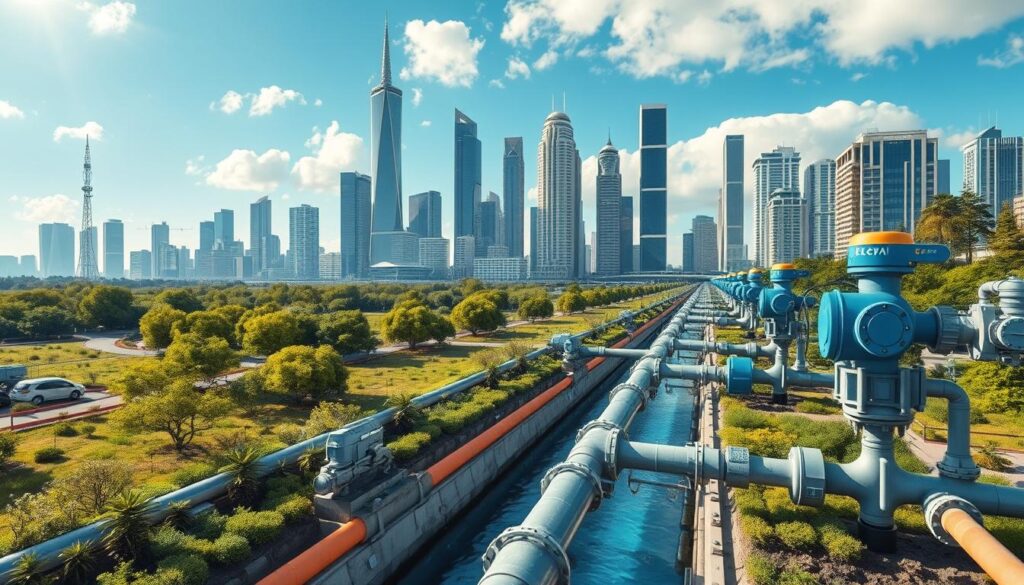
Water efficiency is key as global water stress grows. About two-thirds of the world’s people live in water-stressed areas. This makes smart water management solutions more important than ever.
Real-time Monitoring Solutions
Modern smart water systems use advanced sensors for constant, real-time monitoring. These networks track:
- Water flow rates
- Temperature variations
- Quality indicators
- Potential leak detection
Data Analytics for Water Management
IoT analytics turn raw data into useful insights. Cities like Barcelona and Singapore have seen great results. They use smart water metering systems to:
- Detect unauthorized water usage
- Predict maintenance needs
- Optimize water distribution
- Lower operational costs
“Smart water technologies are not just about monitoring—they’re about intelligent resource management.”
Automated Control Systems
Advanced automated systems can adjust water infrastructure instantly. Machine learning algorithms help predict maintenance, cutting down on system failures.
| Technology | Benefit | Impact |
|---|---|---|
| IoT Sensors | Real-time monitoring | 80% reduction in water theft |
| AI Analytics | Predictive maintenance | Lower repair costs |
| Smart Meters | Consumption tracking | Enhanced water efficiency |
The future of water management is in these smart, connected technologies. They promise sustainable and efficient use of water resources.
Advanced Filtration Technologies
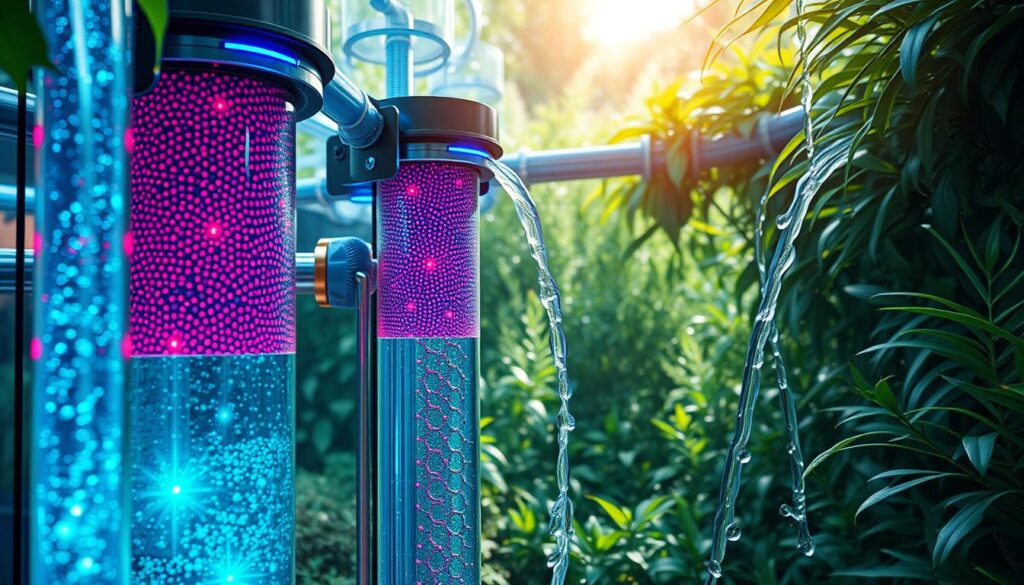
Water infrastructure is changing fast with new filtration technologies. Nanotechnology is leading this change, making it possible to remove contaminants better than ever before.
Water quality is a big problem, and it’s getting worse. The EPA says a lot of our water is not safe for living things:
- 46% of river and stream miles in poor condition
- 21% of lakes showing biological degradation
- 18% of coastal waters experiencing environmental stress
- 32% of wetland areas demonstrating ecological challenges
New membrane filtration technologies are key to solving these problems. Innovative solutions like reverse osmosis and ultrafiltration are better at removing harmful substances than old methods.
“Nanotechnology is revolutionizing water purification, making it more precise.” – Water Innovation Research Center
Some big steps forward in filtration include:
- Nanocomposite membranes with better chemical properties
- Photocatalytic purification systems using titanium dioxide
- Solar-powered water filtration technologies
| Filtration Technology | Contaminant Removal Efficiency | Energy Requirements |
|---|---|---|
| Reverse Osmosis | 99.5% | High |
| Ultrafiltration | 95% | Medium |
| Photocatalytic Systems | 90% | Low |
The future of water infrastructure is about finding affordable, energy-saving filters. We need solutions that work worldwide, where water is scarce.
Nanotechnology Applications in Water Treatment
Nanotechnology is changing water treatment, bringing new solutions for clean water. With 2 billion people facing water scarcity by 2025, nanomaterials are key to solving this problem.

Research shows nanomaterials can make water treatment 50% better than old methods. These tiny technologies use special properties to clean water in new ways.
Nanocomposite Membranes
Nanocomposite membranes are a big step forward in water filtration. They have:
- Improved contaminant removal
- Better water flow
- Less energy use
- Super separation abilities
Graphene-based Solutions
Graphene is a game-changer in water treatment. NematiQ, an Australian startup, has made graphene membranes. They have amazing features:
| Feature | Performance |
|---|---|
| Membrane Permeability | Extremely High |
| Molecular Weight Cut-off | Precisely Tuned |
| Water Transport Efficiency | Superior |
Future of Nano-filtration
The future of nanotechnology in water treatment is bright. Scientists hope to double filtration speed and cut costs in half in five years. They’re working on nanoscale catalysts to replace expensive metals.
“Nanotechnology represents our most innovative approach to solving global water challenges” – Water Research Experts
With water use expected to hit 6000 km³/year by 2100, nanotechnology offers hope. It’s key for sustainable water solutions and better water use.
Innovations in Sustainable Water Infrastructure
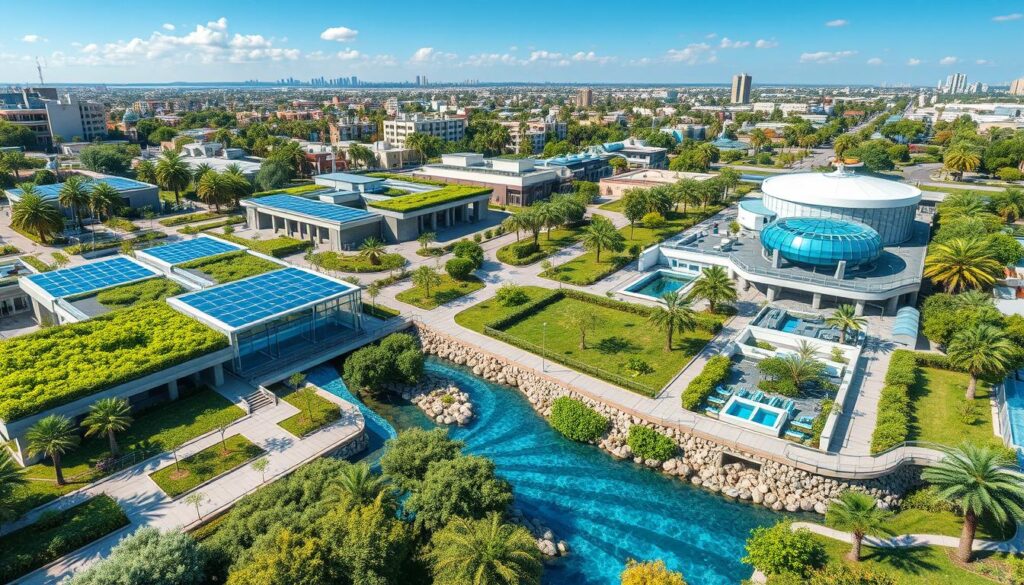
Water scarcity is pushing for new ideas in water infrastructure. Startups worldwide are creating advanced technologies to change how we use water. With half of the world’s people facing water shortages every year, new solutions are key.
The field of green infrastructure is growing fast. It’s focusing on several important areas:
- Advanced desalination techniques
- Energy-efficient water processing
- Sustainable material development
- Smart water recovery systems
New technologies are changing water infrastructure in big ways. Innovations in sustainable water infrastructure use smart sensors, AI, and new materials. This makes water management systems stronger and more efficient.
“Water is the driving force of all nature.” – Leonardo da Vinci
Studies show 1.8 billion people will face severe water shortages soon. This urgent problem is leading to new, efficient, and sustainable solutions.
New green infrastructure solutions include smart filters, local water treatment, and flexible designs. These aim to reduce harm to the environment while using water better.
By mixing new tech with green practices, water systems are becoming smarter. They can now adjust to environmental changes.
Wastewater Processing and Recovery Systems
Modern wastewater treatment has changed a lot. Now, we turn waste into valuable resources. This change is making water management better for cities and industries.
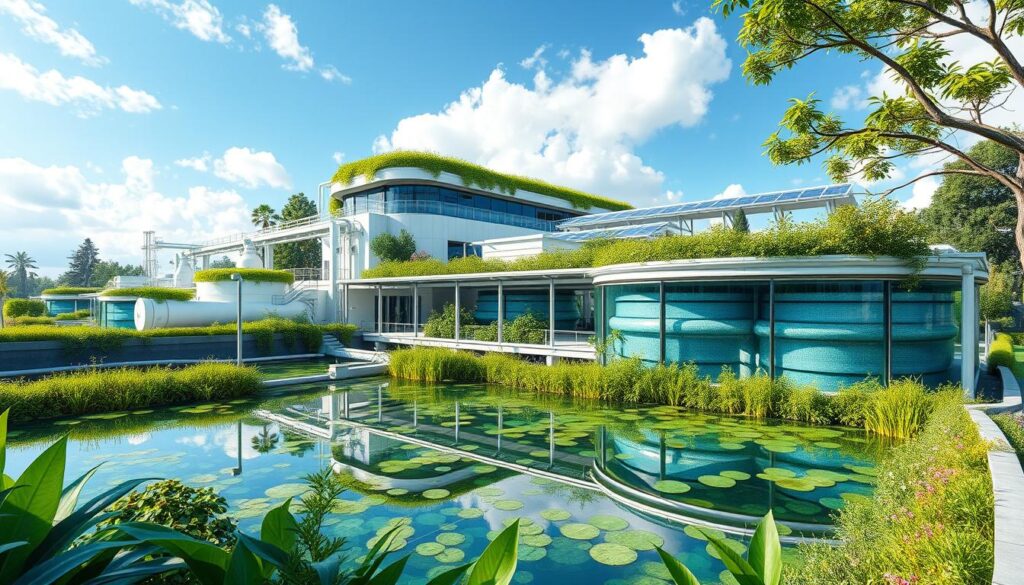
Wastewater processing uses a lot of energy. Cities spend over $2 billion on electricity for this. But, these plants can also make energy and recover resources.
Biological Treatment Methods
New biological treatments use special microbes to clean waste. These methods do several things:
- Lower pollutant levels
- Less harm to the environment
- Make new resources
Chemical Processing Innovations
Chemical treatments have gotten better. Now, they can remove tough pollutants with great accuracy.
Energy Recovery from Wastewater
Water reuse is turning wastewater into energy. New ways make it possible to:
- Make biogas from sludge
- Use heat for buildings
- Get nutrients for farms
“Wastewater is no longer waste—it’s a resource waiting to be unlocked.”
| Resource Recovery Technique | Environmental Benefit | Economic Impact |
|---|---|---|
| Biogas Production | Less Carbon Emissions | Renewable Energy |
| Phosphorus Extraction | Good for Farming | Save on Fertilizers |
| Heat Recovery | More Energy Efficient | Lower Heating Costs |
The future of wastewater management is about the circular economy. It turns treatment plants into places that make new resources.
Decentralized Water Infrastructure Solutions
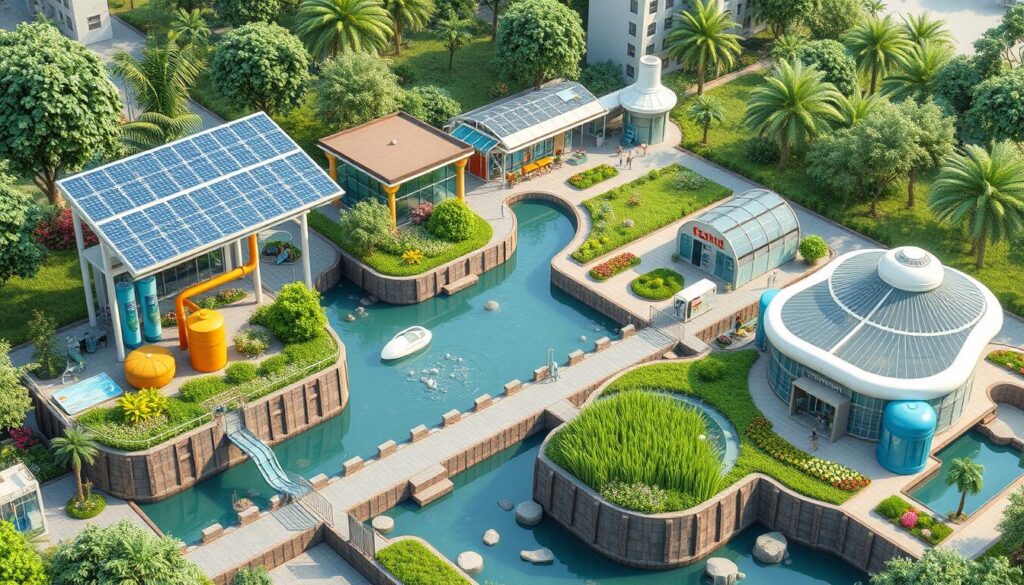
Decentralized water infrastructure is changing how we manage water. It tackles big problems faced by communities with old water systems.
Rural and remote areas have big water challenges. Over 2 million Americans lack proper wastewater infrastructure, posing health risks. Decentralized systems offer a cheaper, better option than big, expensive systems.
“Decentralized water systems bring clean water access directly to communities, transforming local infrastructure capabilities.”
Decentralized water systems have many benefits:
- They use less energy (0.363 kWh/m³ vs. 0.873 kWh/m³ for big systems)
- They cost less to install ($10,000-$30,000 per household)
- They create jobs and boost local economies through maintenance
- They improve health and sanitation
Modern decentralized tech includes smart monitoring. It lets us track water quality in real time and fix problems fast. These systems use IoT and predictive analytics to manage water better.
Decentralized systems also make water use more efficient. Only 3% of Earth’s water is drinkable. Treating water near where it’s used cuts down on transport costs and environmental harm.
Climate-Resilient Water Systems
Water infrastructure is facing big challenges from climate change. Extreme weather events are happening more often. This means we need new ways to manage water that can keep up with the changes.
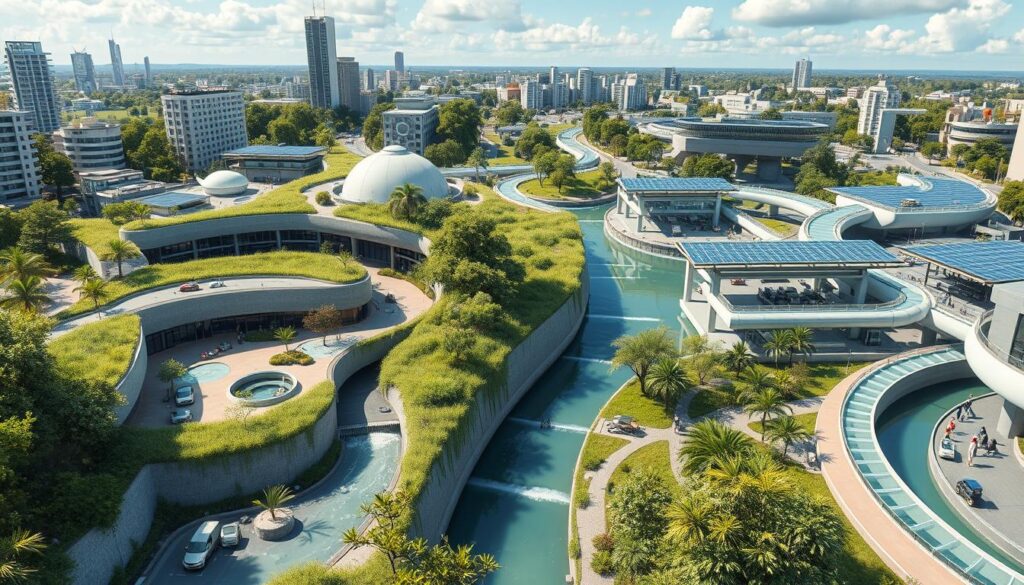
Climate-resilient water systems are a big step forward in design. They use the latest technology to keep water safe and reduce damage from weather changes.
Flood Prevention Technologies
New flood prevention technologies are changing how we manage water in cities. Some key innovations are:
- Advanced monitoring systems using AI predictions
- Smart sensor networks for real-time flood detection
- Adaptive flood barrier systems
- Predictive modeling for possible flood zones
Drought Management Strategies
Water conservation technologies are key in fighting drought. Some strategies include:
- Smart metering systems
- Developing new ways to find water
- Creating smart ways to share water
- Using rainwater harvesting
Adaptive Infrastructure Design
The future of water systems is about being flexible and responsive. Adaptive design principles help water management systems grow with environmental changes. This ensures they stay strong and sustainable over time.
“Water infrastructure must be as dynamic as the climate it serves.” – Water Resource Management Expert
By using the latest technology and planning, cities can build water systems that are ready for the future. These systems will protect communities and keep water safe for generations to come.
Green Infrastructure Integration
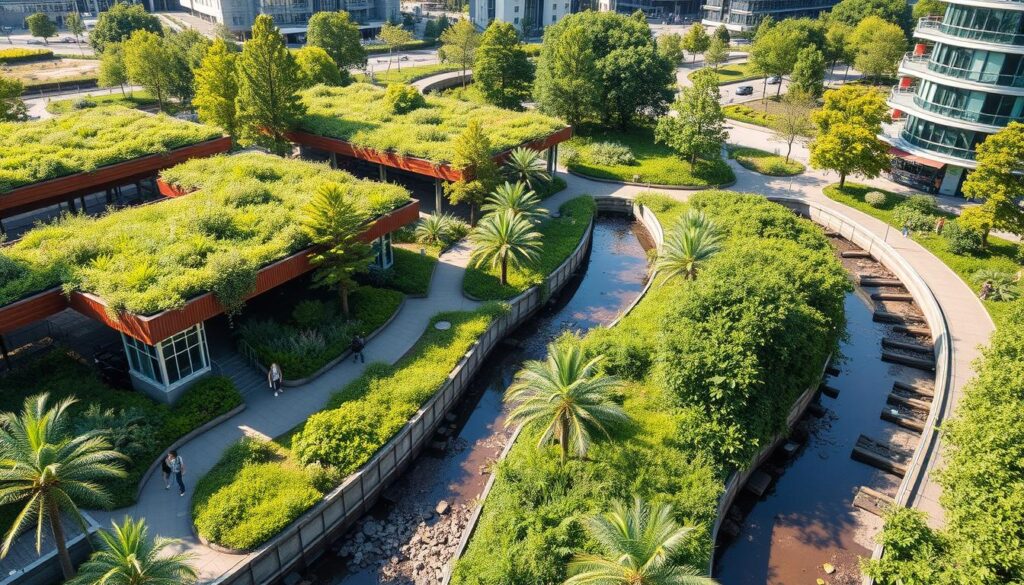
Urban water management is changing with green infrastructure. Cities are now using new water conservation technologies to tackle big environmental problems. An average city block can produce more runoff than a forest of the same size. This shows we really need new ways to handle water.
Green infrastructure combines natural systems with urban areas. It creates smart water management plans. These plans do more than just manage water. They also:
- Capture and filter stormwater
- Lower urban heat island effects
- Boost biodiversity
- Make urban ecosystems healthier
Important parts of green infrastructure are:
- Rain gardens – natural spots that catch and clean rainwater
- Green roofs – roof systems with plants that soak up rain
- Urban wetlands – man-made areas that handle water runoff
“Green infrastructure transforms urban water management from a purely technical challenge into an ecological opportunity.” – Urban Water Sustainability Research Network
These technologies have a big impact. Green infrastructure can catch up to 75 percent of rooftop rainwater. This cuts down on urban runoff and lowers flood risks.
Water Conservation Technologies
Water conservation technologies are changing how we handle our most vital resource. Smart systems and new solutions are making water use better in many areas.
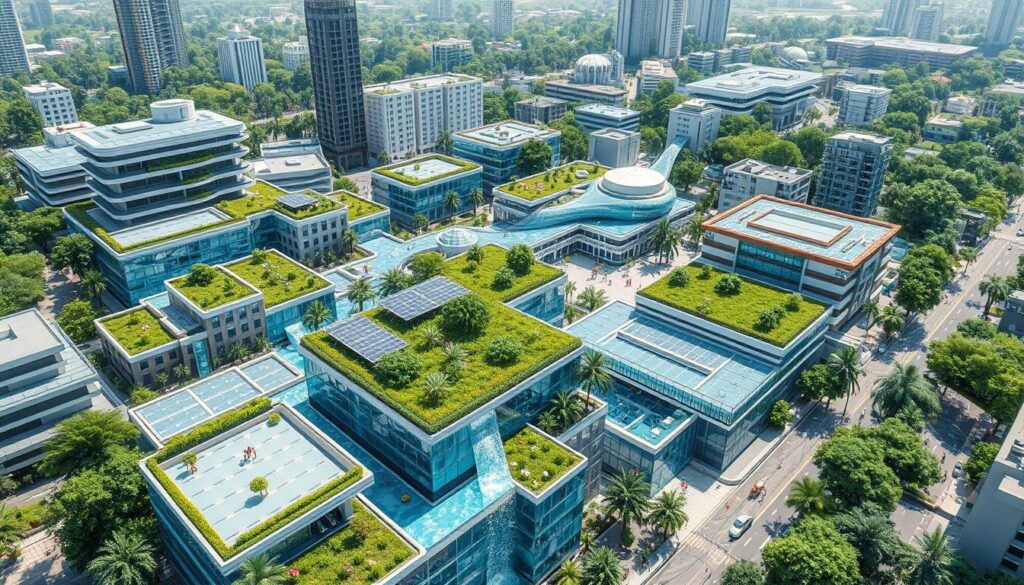
Today’s water-saving methods use the latest tech to cut down on waste. They tackle big water management issues with smart monitoring and smart actions.
Smart Metering Systems
Smart meters give us instant info on how much water we use. Cities like Singapore have set up advanced water systems. These systems spot leaks and track water use right away.
- Real-time water consumption tracking
- Immediate leak identification
- Precise usage analytics
Leak Detection Solutions
Leak detection tech uses AI and machine learning to cut down on water waste. Water companies can find and fix leaks early, avoiding big problems.
AI-driven systems can reduce unnecessary water loss by up to 30% in distribution networks.
Usage Optimization Tools
New water-saving tools include smart irrigation systems. These systems check the weather and soil moisture. For example, Barcelona’s system cuts water use in parks by 25%.
| Technology | Water Savings | Application |
|---|---|---|
| Smart Irrigation | 25% | Urban Parks |
| AI Leak Detection | 30% | Water Distribution |
| Predictive Maintenance | Reduced Repair Costs | Infrastructure Management |
Water-saving tech keeps getting better, giving us smarter ways to manage our most valuable resource.
Emerging Desalination Technologies
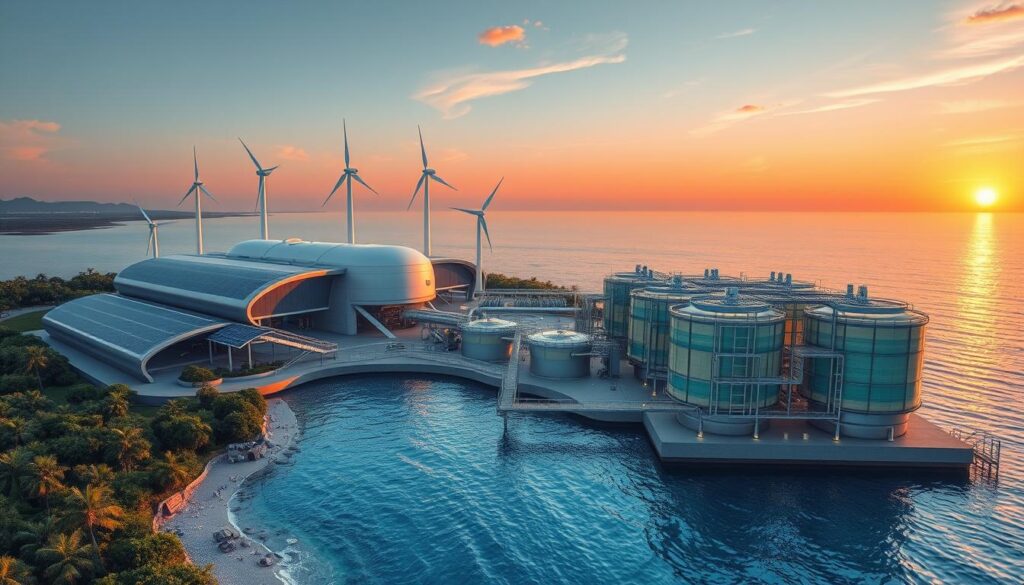
Water scarcity is a big problem worldwide. It’s pushing us to find new ways to treat water. Now, over 20,000 desalination plants make almost 100 million cubic meters of water every day. This is a big help in managing our water resources.
New technologies in desalination are making things better. Reverse osmosis is the main method, using 2 to 5 kWh of energy for every cubic meter of water. Scientists are working hard to make it use less energy and be kinder to the environment.
“The future of water security lies in our ability to innovate and optimize desalination technologies.” – Water Research Institute
- Membrane technology innovations reduce operational costs
- Renewable energy integration minimizes carbon footprint
- Advanced filtration techniques improve water quality
Important updates in water-saving tech include:
- Anti-fouling membrane coatings
- Renewable energy-powered desalination plants
- Enhanced ion exchange techniques
For example, Israel gets about 55% of its water from desalination. This shows how these new technologies can help. The cost of desalination has also gone down by almost 50% in the last 20 years.
With water stress affecting over 2 billion people, these new ways to make water are very important. They offer hope for areas facing water shortages.
Sustainable Urban Water Management
Urban areas face big water challenges today. With more people moving to cities, finding ways to manage water is key. This is important for keeping cities strong and the environment healthy.
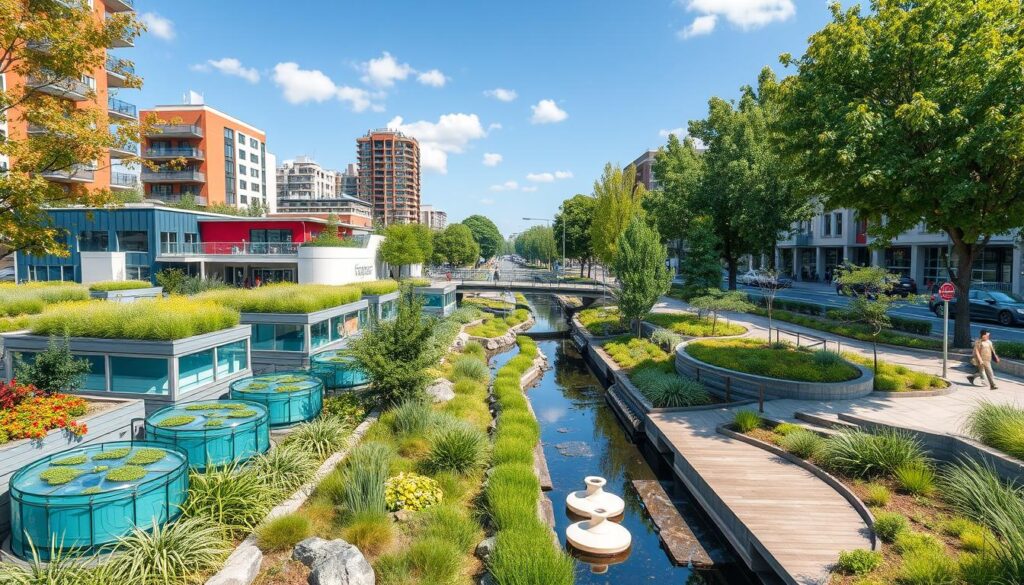
Cities are trying new ways to deal with water issues. They use many strategies to use water better, keep people healthy, and make cities better places to live.
Rainwater Harvesting Systems
Rainwater harvesting is a big help for saving water in cities. Studies show it can cut water use by up to 30%. This is great for cities that don’t have enough water.
- Capture and store rainwater from rooftops
- Reduce stormwater runoff
- Supplement non-potable water needs
- Minimize municipal water consumption
Water Reuse Strategies
Water reuse is changing how cities handle water. Greywater recycling and new treatment methods help cities use water better. This makes water use more efficient.
| Water Reuse Strategy | Water Savings | Urban Use |
|---|---|---|
| Greywater Recycling | 25-40% | Landscape irrigation |
| Industrial Process Reuse | 50-70% | Cooling systems |
| Treated Wastewater | 30-60% | Agricultural irrigation |
Urban Planning Integration
Good urban planning is key for managing water. Mixing water systems with parks, drainage, and community needs makes cities better. This makes cities more able to handle challenges.
“Water is the driving force of all nature.” – Leonardo da Vinci
By 2050, nearly 50% of city dwellers might not have enough water. It’s vital to use all methods to manage water well. This is not just a choice, but a must for cities to thrive in the future.
Infrastructure Monitoring and Maintenance
Smart water management systems have changed how we track and care for water infrastructure. Digital sensors and IoT devices let us monitor water networks in real-time. This cuts energy use by 15-20% by quickly spotting where things go wrong.
These tools give us a clear view of complex water systems. They help find leaks, check water quality, and stop service problems before they start.
Water efficiency is key as old infrastructure needs fixing. Many U.S. water systems are over 50 years old and need big upgrades. This is to avoid contamination and keep water flowing reliably.
Advanced metering and predictive maintenance can save 20-30% in costs. They help utilities use resources better.
AI and 5G have made monitoring water systems much better. Water teams can now use data to make quick, smart choices about maintenance. Even with skill gaps, these new ways are vital for safe, lasting water systems.
Investing in monitoring tech makes water systems stronger. It also tackles big water security issues. By using smart water systems, communities can manage their water better. This cuts down on water loss, energy use, and ensures water for generations to come.






